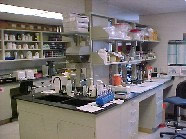Monkeying Around With Genes Leads to Effective Simian Model
by Jeffrey Laurence, M.D.

Dr. Zandrea Ambrose |
April 9, 2009—Evolution has bestowed upon cells from virtually all animals the ability to naturally inhibit the growth of many viruses—defenses that are distinct from their immune systems. For monkeys, this gift includes proteins that can protect against simian counterparts of the human AIDS virus. Unfortunately for people, the ability of similar proteins in human cells to fend off HIV is counteracted by specialized pieces of HIV itself. For scientists who might hope to use monkeys to help test potential anti-HIV drugs and vaccines before they are tried out in humans, the HIV-fighting natural proteins in monkeys represent an impediment.
But Dr. Zandrea Ambrose, working initially as an amfAR-funded scholar and subsequently as an amfAR research grant recipient, together with colleagues at the National Cancer Institute and Rockefeller University, has now engineered a form of the most prevalent type of AIDS virus, HIV-1, that is capable of infecting a small monkey, the pig-tailed macaque.
Writing in the March issue of the prestigious Proceedings of the National Academy of Sciences, Dr. Ambrose and associates described replacing a gene in HIV-1 known as Vif with its counterpart either from a monkey AIDS virus or from HIV-2, the type of HIV prevalent in West Africa. These minimally altered forms of HIV-1 could now grow to high levels in the monkeys.

The Ambrose laboratory
|
The infections persisted for many months, accompanied by modest declines in CD4 T-cell counts. More interesting was the response of these animals to standard anti-HIV drugs. Dr. Ambrose’s modified AIDS viruses were sensitive to all classes of anti-HIV drugs tested. In particular, Atripla—a commonly used, daily single-dose therapy containing three anti-drugs—was highly effective against these viruses in the test tube and in the monkeys. And when these drugs were injected into two monkeys daily for one week before and one week after an intravenous challenge with the virus, neither animal became infected. This demonstrated the drugs’ effectiveness as pre-exposure prophylaxis (PrEP) against infection.
There is much more work to do in order to understand these modified viruses. It is important to determine if they can infect monkeys when applied to their genital tissues rather than simply being injected into a vein. In addition, it should be noted that the parent strain of HIV-1 that was modified was based on a type particularly sensitive to neutralization by vaccine antibodies, and it did not cause the profound and progressive loss of T cells characteristic of untreated HIV-1 in humans. Modifying a more typical form of HIV-1 might be better for testing vaccines and immune enhancing drugs in this model. But it is very encouraging that, for the first time, researchers have been able to develop a monkey model involving HIV-1, not some monkey counterpart. Their utility could be enormous in the screening and toxicity testing of anti-HIV drugs before they are tried out in humans.
Dr. Jeffrey Laurence is amfAR’s senior scientific consultant.
Related articles